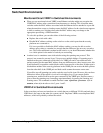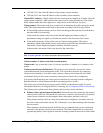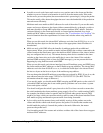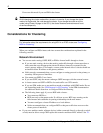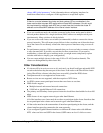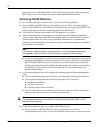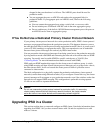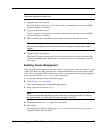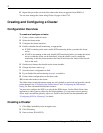
Nokia Network Voyager for IPSO 4.0 Reference Guide 213
In multicast mode each cluster node receives every packet sent to the cluster and decides
whether to process it based on information it receives from the master node. If the node
decides not to process the packet (because another node is processing it), it drops the packet.
This mode usually offers better throughput because it uses the bandwidth of the production
networks more efficiently.
Multicast mode uses multicast MAC addresses for each of the nodes. If you use this mode,
routers and servers adjacent to the cluster (either connected directly or through a switch or
hub) must be able to accept ARP replies that contain a multicast MAC address. Switches
connected directly to the cluster must be able to forward packets destined for a single
(multicast) MAC address out multiple switch ports. See “Considerations for Clustering” for
more information about the requirements for routers and switches when using multicast
mode.
When you use this mode, the cluster MAC addresses are in the form 01:50:5A:xx:xx:xx, in
which the last three bytes are the last three bytes of the appropriate cluster IP address in
hexadecimal.
Multicast mode with IGMP offers the benefits of multicast mode with an additional
improvement. When you use multicast mode (without IGMP), the switches connected to the
cluster broadcast the data frames sent to the multicast MAC addresses of the cluster (unless
they are configured not to do so). This means that any other devices attached to the same
switches as the cluster also receive the traffic that is sent to the cluster. If the switches
perform IGMP snooping (elicit or listen for IGMP messages), you can prevent this from
happening by using multicast mode with IGMP.
When you use this mode, each cluster interface joins an IP multicast group, and IPSO bases
the cluster multicast MAC addresses on the IP multicast group addresses. The cluster MAC
addresses are in the form 01:00:5E:xx:xx:xx, in which the fourth byte is the cluster ID and
the last two bytes are the last two bytes of the multicast group address.
You can change the default IP multicast group addresses assigned by IPSO. If you do so, the
new addresses must be in the range 239.0.0.0 to 239.255.255.255. (See RFC 2365 for
information about this range of addresses.)
If you use this mode, you should enable IGMP snooping and IGMP queries on the switch. If
you enable IGMP snooping but do not enable queries, problems can occur when a system
leaves and rejoins a cluster.
You should configure the switch’s query intervals to be 30 or fewer seconds to ensure that
the switch maintains the cluster multicast group properly. On a Cisco switch running CatOS,
for example, the default values for querier interval (QI) and other querier interval (OQI)
might be too large, which can cause the switch to remove some of the cluster interfaces from
their multicast group and therefore prevent traffic from being forwarded.
In forwarding mode the master cluster node initially receives all the packets sent to the
cluster and decides which node should process the packet. If it decides that another node
should handle the packet, it forwards the packet to that node. Otherwise, the master
processes the packet itself.
Use forwarding mode if the routers and switches on either side of the cluster do not support
multicast MAC addresses.



